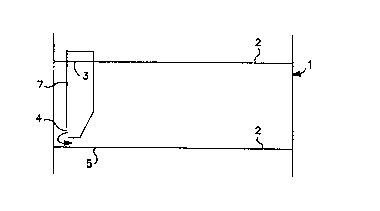Some of the information on this Web page has been provided by external sources. The Government of Canada is not responsible for the accuracy, reliability or currency of the information supplied by external sources. Users wishing to rely upon this information should consult directly with the source of the information. Content provided by external sources is not subject to official languages, privacy and accessibility requirements.
Any discrepancies in the text and image of the Claims and Abstract are due to differing posting times. Text of the Claims and Abstract are posted:
| (12) Patent Application: | (11) CA 2277214 |
|---|---|
| (54) English Title: | FRACTIONATION TRAYS |
| (54) French Title: | PLATEAU DE FRACTIONNEMENT |
| Status: | Deemed Abandoned and Beyond the Period of Reinstatement - Pending Response to Notice of Disregarded Communication |
| (51) International Patent Classification (IPC): |
|
|---|---|
| (72) Inventors : |
|
| (73) Owners : |
|
| (71) Applicants : |
|
| (74) Agent: | GOWLING WLG (CANADA) LLP |
| (74) Associate agent: | |
| (45) Issued: | |
| (86) PCT Filing Date: | 1997-01-27 |
| (87) Open to Public Inspection: | 1998-07-30 |
| Examination requested: | 1999-07-08 |
| Availability of licence: | N/A |
| Dedicated to the Public: | N/A |
| (25) Language of filing: | English |
| Patent Cooperation Treaty (PCT): | Yes |
|---|---|
| (86) PCT Filing Number: | PCT/US1997/001234 |
| (87) International Publication Number: | US1997001234 |
| (85) National Entry: | 1999-07-08 |
| (30) Application Priority Data: | None |
|---|
A fractionating column (1) is provided which has perforated fractionating
trays (2) and downcomers (7) allowing liquid to flow from one tray to the tray
immediately below, said downcomers being provided with radial outflow ports
(4) directing downflowing liquids towards the column wall rather than onto the
surface of the tray directly below the downcomer. This permits at least a
portion of the under-downcomer area to be perforated thereby increasing the
capacity of the tray for vapor/liquid contact and ensuring that weeping of the
liquid through the perforations is avoided without need for an increase in
vapor pressure.
L'invention concerne une colonne (1) de fractionnement comprenant des plateaux (2) de fractionnement perforés et des déversoirs (7) permettant l'écoulement d'un liquide d'un plateau vers le plateau placé immédiatement dessous, lesdits déversoirs étant pourvus d'orifices (4) d'écoulement radial envoyant les liquides à courant descendant vers la paroi de la colonne plutôt que sur la surface du plateau immédiatement au-dessous du déversoir. Ceci permet au moins la perforation d'une partie de la zone se trouvant sous le déversoir, ce qui a pour effet d'augmenter la capacité du plateau pour un contact vapeur/liquide et d'éviter l'écoulement du liquide par les perforations, sans avoir à augmenter la pression de vapeur.
Note: Claims are shown in the official language in which they were submitted.
Note: Descriptions are shown in the official language in which they were submitted.

2024-08-01:As part of the Next Generation Patents (NGP) transition, the Canadian Patents Database (CPD) now contains a more detailed Event History, which replicates the Event Log of our new back-office solution.
Please note that "Inactive:" events refers to events no longer in use in our new back-office solution.
For a clearer understanding of the status of the application/patent presented on this page, the site Disclaimer , as well as the definitions for Patent , Event History , Maintenance Fee and Payment History should be consulted.
| Description | Date |
|---|---|
| Application Not Reinstated by Deadline | 2002-01-28 |
| Time Limit for Reversal Expired | 2002-01-28 |
| Deemed Abandoned - Failure to Respond to Maintenance Fee Notice | 2001-01-29 |
| Inactive: Cover page published | 1999-09-29 |
| Inactive: First IPC assigned | 1999-09-01 |
| Inactive: IPC assigned | 1999-09-01 |
| Inactive: Acknowledgment of national entry - RFE | 1999-08-18 |
| Letter Sent | 1999-08-18 |
| Application Received - PCT | 1999-08-13 |
| All Requirements for Examination Determined Compliant | 1999-07-08 |
| Request for Examination Requirements Determined Compliant | 1999-07-08 |
| Application Published (Open to Public Inspection) | 1998-07-30 |
| Abandonment Date | Reason | Reinstatement Date |
|---|---|---|
| 2001-01-29 |
The last payment was received on 1999-12-30
Note : If the full payment has not been received on or before the date indicated, a further fee may be required which may be one of the following
Patent fees are adjusted on the 1st of January every year. The amounts above are the current amounts if received by December 31 of the current year.
Please refer to the CIPO
Patent Fees
web page to see all current fee amounts.
| Fee Type | Anniversary Year | Due Date | Paid Date |
|---|---|---|---|
| Request for examination - standard | 1999-07-08 | ||
| Basic national fee - standard | 1999-07-08 | ||
| Registration of a document | 1999-07-08 | ||
| MF (application, 2nd anniv.) - standard | 02 | 1999-01-27 | 1999-07-08 |
| MF (application, 3rd anniv.) - standard | 03 | 2000-01-27 | 1999-12-30 |
Note: Records showing the ownership history in alphabetical order.
| Current Owners on Record |
|---|
| NORTON CHEMICAL PROCESS PRODUCTS CORPORATION |
| Past Owners on Record |
|---|
| JOHN HARRIS |
| JOHN R. SAUTER |
| RICHARD P. HAUSER |